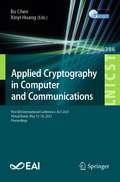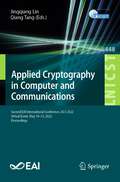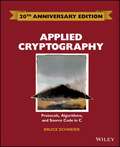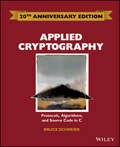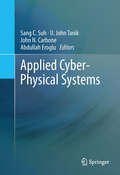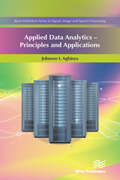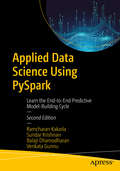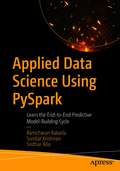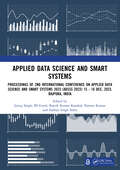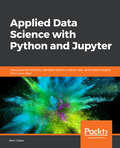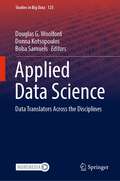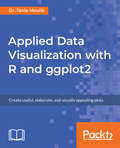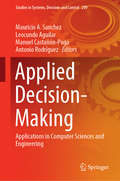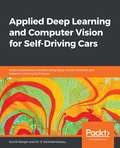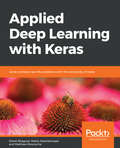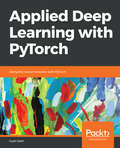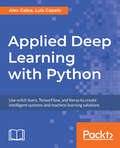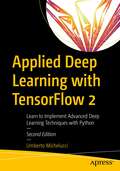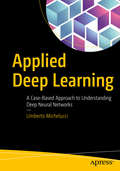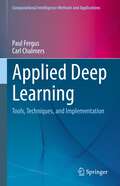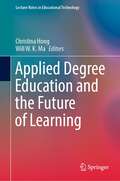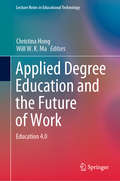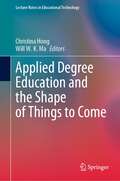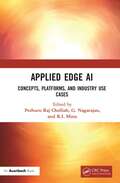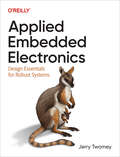- Table View
- List View
Applied Cryptography in Computer and Communications: First EAI International Conference, AC3 2021, Virtual Event, May 15-16, 2021, Proceedings (Lecture Notes of the Institute for Computer Sciences, Social Informatics and Telecommunications Engineering #386)
by Bo Chen Xinyi HuangThis book constitutes the refereed post-conference proceedings of the First International Conference on Applied Cryptography in Computer and Communications, AC3 2021, and the First International Workshop on Security for Internet of Things (IoT). The conference was held in May 2021 and due to COVID-19 pandemic virtually.The 15 revised full papers were carefully reviewed and selected from 42 submissions. The papers present are grouped in 4 tracks on blockchain; authentication; secure computation; practical crypto application. They detail technical aspects of applied cryptography, including symmetric cryptography, public-key cryptography, cryptographic protocols, cryptographic implementations, cryptographic standards and practices.
Applied Cryptography in Computer and Communications: Second EAI International Conference, AC3 2022, Virtual Event, May 14-15, 2022, Proceedings (Lecture Notes of the Institute for Computer Sciences, Social Informatics and Telecommunications Engineering #448)
by Jingqiang Lin Qiang TangThis book constitutes the refereed post-conference proceedings of the Second International Conference on Applied Cryptography in Computer and Communications, AC3 2022, held May 14-15, 2022 and due to COVID-19 pandemic virtually.The 12 revised full papers and 2 short papers were carefully reviewed and selected from 38 submissions. They were organized in topical sections as follows: quantum-safe cryptographic solution; applied cryptography for IoT; authentication protocol; real-world applied cryptography; network attack and defense; security application.
Applied Cryptography: Protocols, Algorithms and Source Code in C
by Bruce SchneierFrom the world's most renowned security technologist, Bruce Schneier, this 20th Anniversary Edition is the most definitive reference on cryptography ever published and is the seminal work on cryptography. Cryptographic techniques have applications far beyond the obvious uses of encoding and decoding information. For developers who need to know about capabilities, such as digital signatures, that depend on cryptographic techniques, there's no better overview than Applied Cryptography, the definitive book on the subject. Bruce Schneier covers general classes of cryptographic protocols and then specific techniques, detailing the inner workings of real-world cryptographic algorithms including the Data Encryption Standard and RSA public-key cryptosystems. The book includes source-code listings and extensive advice on the practical aspects of cryptography implementation, such as the importance of generating truly random numbers and of keeping keys secure. ". . .the best introduction to cryptography I've ever seen. . . .The book the National Security Agency wanted never to be published. . . ." -Wired Magazine ". . .monumental . . . fascinating . . . comprehensive . . . the definitive work on cryptography for computer programmers . . ." -Dr. Dobb's Journal ". . .easily ranks as one of the most authoritative in its field." -PC Magazine The book details how programmers and electronic communications professionals can use cryptography-the technique of enciphering and deciphering messages-to maintain the privacy of computer data. It describes dozens of cryptography algorithms, gives practical advice on how to implement them into cryptographic software, and shows how they can be used to solve security problems. The book shows programmers who design computer applications, networks, and storage systems how they can build security into their software and systems. With a new Introduction by the author, this premium edition will be a keepsake for all those committed to computer and cyber security.
Applied Cyber-Physical Systems
by Abdullah Eroglu Sang C. Suh John N. Carbone U. John TanikApplied Cyber-Physical Systems presents the latest methods and technologies in the area of cyber-physical systems including medical and biological applications. Cyber-physical systems (CPS) integrate computing and communication capabilities by monitoring, and controlling the physical systems via embedded hardware and computers. This book brings together unique contributions from renowned experts on cyber-physical systems research and education with applications. It also addresses the major challenges in CPS, and then provides a resolution with various diverse applications as examples. Advanced-level students and researchers focused on computer science, engineering and biomedicine will find this to be a useful secondary text book or reference, as will professionals working in this field.
Applied Data Analytics - Principles and Applications
by Johnson I. AgbinyaThe emergence of huge amounts of data which require analysis and in some cases real-time processing has forced exploration into fast algorithms for handling very lage data sizes. Analysis of x-ray images in medical applications, cyber security data, crime data, telecommunications and stock market data, health records and business analytics data are but a few areas of interest. Applications and platforms including R, RapidMiner and Weka provide the basis for analysis, often used by practitioners who pay little to no attention to the underlying mathematics and processes impacting the data. This often leads to an inability to explain results or correct mistakes, or to spot errors.Applied Data Analytics - Principles and Applications seeks to bridge this missing gap by providing some of the most sought after techniques in big data analytics. Establishing strong foundations in these topics provides practical ease when big data analyses are undertaken using the widely available open source and commercially orientated computation platforms, languages and visualisation systems. The book, when combined with such platforms, provides a complete set of tools required to handle big data and can lead to fast implementations and applications.The book contains a mixture of machine learning foundations, deep learning, artificial intelligence, statistics and evolutionary learning mathematics written from the usage point of view with rich explanations on what the concepts mean. The author has thus avoided the complexities often associated with these concepts when found in research papers. The tutorial nature of the book and the applications provided are some of the reasons why the book is suitable for undergraduate, postgraduate and big data analytics enthusiasts.This text should ease the fear of mathematics often associated with practical data analytics and support rapid applications in artificial intelligence, environmental sensor data modelling and analysis, health informatics, business data analytics, data from Internet of Things and deep learning applications.
Applied Data Science Using PySpark: Learn the End-to-End Predictive Model-Building Cycle
by Ramcharan Kakarla Sundar Krishnan Balaji Dhamodharan Venkata GunnuThis comprehensive guide, featuring hand-picked examples of daily use cases, will walk you through the end-to-end predictive model-building cycle using the latest techniques and industry tricks. In Chapters 1, 2, and 3, we will begin by setting up the environment and covering the basics of PySpark, focusing on data manipulation. Chapter 4 delves into the art of variable selection, demonstrating various techniques available in PySpark. In Chapters 5, 6, and 7, we explore machine learning algorithms, their implementations, and fine-tuning techniques. Chapters 8 and 9 will guide you through machine learning pipelines and various methods to operationalize and serve models using Docker/API. Chapter 10 will demonstrate how to unlock the power of predictive models to create a meaningful impact on your business. Chapter 11 introduces some of the most widely used and powerful modeling frameworks to unlock real value from data. In this new edition, you will learn predictive modeling frameworks that can quantify customer lifetime values and estimate the return on your predictive modeling investments. This edition also includes methods to measure engagement and identify actionable populations for effective churn treatments. Additionally, a dedicated chapter on experimentation design has been added, covering steps to efficiently design, conduct, test, and measure the results of your models. All code examples have been updated to reflect the latest stable version of Spark. You will: Gain an overview of end-to-end predictive model building Understand multiple variable selection techniques and their implementations Learn how to operationalize models Perform data science experiments and learn useful tips
Applied Data Science Using PySpark: Learn the End-to-End Predictive Model-Building Cycle
by Sridhar Alla Ramcharan Kakarla Sundar KrishnanDiscover the capabilities of PySpark and its application in the realm of data science. This comprehensive guide with hand-picked examples of daily use cases will walk you through the end-to-end predictive model-building cycle with the latest techniques and tricks of the trade. Applied Data Science Using PySpark is divided unto six sections which walk you through the book. In section 1, you start with the basics of PySpark focusing on data manipulation. We make you comfortable with the language and then build upon it to introduce you to the mathematical functions available off the shelf. In section 2, you will dive into the art of variable selection where we demonstrate various selection techniques available in PySpark. In section 3, we take you on a journey through machine learning algorithms, implementations, and fine-tuning techniques. We will also talk about different validation metrics and how to use them for picking the best models. Sections 4 and 5 go through machine learning pipelines and various methods available to operationalize the model and serve it through Docker/an API. In the final section, you will cover reusable objects for easy experimentation and learn some tricks that can help you optimize your programs and machine learning pipelines. By the end of this book, you will have seen the flexibility and advantages of PySpark in data science applications. This book is recommended to those who want to unleash the power of parallel computing by simultaneously working with big datasets. What You Will Learn Build an end-to-end predictive modelImplement multiple variable selection techniquesOperationalize modelsMaster multiple algorithms and implementations Who This Book is For Data scientists and machine learning and deep learning engineers who want to learn and use PySpark for real-time analysis of streaming data.
Applied Data Science and Smart Systems
by Naveen Kumar Jaiteg Singh S B Goyal Rajesh Kumar Kaushal Sukhjit Singh SehraThe Second International Conference on Applied Data Science and Smart Systems (ADSSS-2023) was held on 15-16 December 2023 at Chitkara University, Punjab, India. This multidisciplinary conference focussed on innovation and progressive practices in science, technology, and management. The conference successfully brought together researchers, academicians, and practitioners across different domains such as artificial intelligence and machine learning, software engineering, automation, data science, business computing, data communication and computer networks. The presenters shared their most recent research works that are critical to contemporary business and societal landscape and encouraged the participants to devise solutions for real-world challenges.The Open Access version of this book, available at www.taylorfrancis.com, has been made available under a Creative Commons [Attribution-Non Commercial-No Derivatives (CC-BY-NC-ND)] 4.0 license.
Applied Data Science with Python and Jupyter: Use powerful industry-standard tools to unlock new, actionable insights from your data
by Alex GaleaBecome the master player of data exploration by creating reproducible data processing pipelines, visualizations, and prediction models for your applications.Key FeaturesGet up and running with the Jupyter ecosystem and some example datasetsLearn about key machine learning concepts such as SVM, KNN classifiers, and Random ForestsDiscover how you can use web scraping to gather and parse your own bespoke datasetsBook DescriptionGetting started with data science doesn't have to be an uphill battle. Applied Data Science with Python and Jupyter is a step-by-step guide ideal for beginners who know a little Python and are looking for a quick, fast-paced introduction to these concepts. In this book, you'll learn every aspect of the standard data workflow process, including collecting, cleaning, investigating, visualizing, and modeling data. You'll start with the basics of Jupyter, which will be the backbone of the book. After familiarizing ourselves with its standard features, you'll look at an example of it in practice with our first analysis. In the next lesson, you dive right into predictive analytics, where multiple classification algorithms are implemented. Finally, the book ends by looking at data collection techniques. You'll see how web data can be acquired with scraping techniques and via APIs, and then briefly explore interactive visualizations.What you will learnGet up and running with the Jupyter ecosystemIdentify potential areas of investigation and perform exploratory data analysisPlan a machine learning classification strategy and train classification modelsUse validation curves and dimensionality reduction to tune and enhance your modelsScrape tabular data from web pages and transform it into Pandas DataFramesCreate interactive, web-friendly visualizations to clearly communicate your findingsWho this book is forApplied Data Science with Python and Jupyter is ideal for professionals with a variety of job descriptions across a large range of industries, given the rising popularity and accessibility of data science. You'll need some prior experience with Python, with any prior work with libraries such as Pandas, Matplotlib, and Pandas providing you a useful head start.
Applied Data Science: Data Translators Across the Disciplines (Studies in Big Data #125)
by Boba Samuels Donna Kotsopoulos Douglas G. WoolfordThe use of data to guide action is growing. Even the public uses data to guide everyday decisions! How do we develop data acumen across a broad range of fields and varying levels of expertise? How do we foster the development of effective data translators? This book explores these questions, presenting an interdisciplinary collection of edited contributions across fields such as education, health sciences, natural sciences, politics, economics, business and management studies, social sciences, and humanities. Authors illustrate how to use data within a discipline, including visualization and analysis, translating and communicating results, and pedagogical considerations. This book is of interest to scholars and anyone looking to understand the use of data science across disciplines. It is ideal in a course for non-data science majors exploring how data translation occurs in various contexts and for professionals looking to engage in roles requiring data translation.
Applied Data Visualization with R and ggplot2: Create useful, elaborate, and visually appealing plots
by Dr Tania MoulikDevelop informative and aesthetic visualizations that enable effective data analysis in less timeKey FeaturesDiscover structure of ggplot2, grammar of graphics, and geometric objectsStudy how to design and implement visualization from scratchExplore the advantages of using advanced plotsBook DescriptionApplied Data Visualization with R and ggplot2 introduces you to the world of data visualization by taking you through the basic features of ggplot2. To start with, you’ll learn how to set up the R environment, followed by getting insights into the grammar of graphics and geometric objects before you explore the plotting techniques.You’ll discover what layers, scales, coordinates, and themes are, and study how you can use them to transform your data into aesthetical graphs. Once you’ve grasped the basics, you’ll move on to studying simple plots such as histograms and advanced plots such as superimposing and density plots. You’ll also get to grips with plotting trends, correlations, and statistical summaries.By the end of this book, you’ll have created data visualizations that will impress your clients.What you will learnSet up the R environment, RStudio, and understand structure of ggplot2Distinguish variables and use best practices to visualize themChange visualization defaults to reveal more information about dataImplement the grammar of graphics in ggplot2 such as scales and facetingBuild complex and aesthetic visualizations with ggplot2 analysis methodsLogically and systematically explore complex relationshipsCompare variables in a single visual, with advanced plotting methodsWho this book is forApplied Data Visualization with R and ggplot2 is for you if you are a professional working with data and R. This book is also for students who want to enhance their data analysis skills by adding informative and professional visualizations. It is assumed that you know basics of the R language and its commands and objects.
Applied Decision-Making: Applications in Computer Sciences and Engineering (Studies in Systems, Decision and Control #209)
by Mauricio A. Sanchez Leocundo Aguilar Manuel Castañón-Puga Antonio RodríguezThis book gathers a collection of the latest research, applications, and proposals, introducing readers to innovations and concepts from diverse environments and systems. As such, it will provide students and professionals alike with not only cutting-edge information, but also new inspirations and potential research directions.Each chapter focuses on a specific aspect of applied decision making, e.g. in complex systems, computational intelligence, security, and ubiquitous computing.
Applied Deep Learning and Computer Vision for Self-Driving Cars: Build autonomous vehicles using deep neural networks and behavior-cloning techniques
by Sumit Ranjan Dr. S. SenthamilarasuExplore self-driving car technology using deep learning and artificial intelligence techniques and libraries such as TensorFlow, Keras, and OpenCV Key Features Build and train powerful neural network models to build an autonomous car Implement computer vision, deep learning, and AI techniques to create automotive algorithms Overcome the challenges faced while automating different aspects of driving using modern Python libraries and architectures Book Description Thanks to a number of recent breakthroughs, self-driving car technology is now an emerging subject in the field of artificial intelligence and has shifted data scientists' focus to building autonomous cars that will transform the automotive industry. This book is a comprehensive guide to use deep learning and computer vision techniques to develop autonomous cars. Starting with the basics of self-driving cars (SDCs), this book will take you through the deep neural network techniques required to get up and running with building your autonomous vehicle. Once you are comfortable with the basics, you'll delve into advanced computer vision techniques and learn how to use deep learning methods to perform a variety of computer vision tasks such as finding lane lines, improving image classification, and so on. You will explore the basic structure and working of a semantic segmentation model and get to grips with detecting cars using semantic segmentation. The book also covers advanced applications such as behavior-cloning and vehicle detection using OpenCV, transfer learning, and deep learning methodologies to train SDCs to mimic human driving. By the end of this book, you'll have learned how to implement a variety of neural networks to develop your own autonomous vehicle using modern Python libraries. What you will learn Implement deep neural network from scratch using the Keras library Understand the importance of deep learning in self-driving cars Get to grips with feature extraction techniques in image processing using the OpenCV library Design a software pipeline that detects lane lines in videos Implement a convolutional neural network (CNN) image classifier for traffic signal signs Train and test neural networks for behavioral-cloning by driving a car in a virtual simulator Discover various state-of-the-art semantic segmentation and object detection architectures Who this book is for If you are a deep learning engineer, AI researcher, or anyone looking to implement deep learning and computer vision techniques to build self-driving blueprint solutions, this book is for you. Anyone who wants to learn how various automotive-related algorithms are built, will also find this book useful. Python programming experience, along with a basic understanding of deep learning, is necessary to get the most of this book.
Applied Deep Learning with Keras: Solve complex real-life problems with the simplicity of Keras
by Ritesh Bhagwat Mahla Abdolahnejad Matthew MoocarmeTake your neural networks to a whole new level with the simplicity and modularity of Keras, the most commonly used high-level neural networks API.Key FeaturesSolve complex machine learning problems with precisionEvaluate, tweak, and improve your deep learning models and solutionsUse different types of neural networks to solve real-world problemsBook DescriptionThough designing neural networks is a sought-after skill, it is not easy to master. With Keras, you can apply complex machine learning algorithms with minimum code.Applied Deep Learning with Keras starts by taking you through the basics of machine learning and Python all the way to gaining an in-depth understanding of applying Keras to develop efficient deep learning solutions. To help you grasp the difference between machine and deep learning, the book guides you on how to build a logistic regression model, first with scikit-learn and then with Keras. You will delve into Keras and its many models by creating prediction models for various real-world scenarios, such as disease prediction and customer churning. You’ll gain knowledge on how to evaluate, optimize, and improve your models to achieve maximum information. Next, you’ll learn to evaluate your model by cross-validating it using Keras Wrapper and scikit-learn. Following this, you’ll proceed to understand how to apply L1, L2, and dropout regularization techniques to improve the accuracy of your model. To help maintain accuracy, you’ll get to grips with applying techniques including null accuracy, precision, and AUC-ROC score techniques for fine tuning your model.By the end of this book, you will have the skills you need to use Keras when building high-level deep neural networks.What you will learnUnderstand the difference between single-layer and multi-layer neural network modelsUse Keras to build simple logistic regression models, deep neural networks, recurrent neural networks, and convolutional neural networksApply L1, L2, and dropout regularization to improve the accuracy of your modelImplement cross-validate using Keras wrappers with scikit-learnUnderstand the limitations of model accuracyWho this book is forIf you have basic knowledge of data science and machine learning and want to develop your skills and learn about artificial neural networks and deep learning, you will find this book useful. Prior experience of Python programming and experience with statistics and logistic regression will help you get the most out of this book. Although not necessary, some familiarity with the scikit-learn library will be an added bonus.
Applied Deep Learning with PyTorch: Demystify neural networks with PyTorch
by Hyatt SalehImplement techniques such as image classification and natural language processing (NLP) by understanding the different neural network architecturesKey FeaturesUnderstand deep learning and how it can solve complex real-world problemsApply deep learning for image classification and text processing using neural networks Develop deep learning solutions for tasks such as basic classification and solving style transfer problemsBook DescriptionMachine learning is rapidly becoming the most preferred way of solving data problems, thanks to the huge variety of mathematical algorithms that find patterns, which are otherwise invisible to us. Applied Deep Learning with PyTorch takes your understanding of deep learning, its algorithms, and its applications to a higher level. The book begins by helping you browse through the basics of deep learning and PyTorch. Once you are well versed with the PyTorch syntax and capable of building a single-layer neural network, you will gradually learn to tackle more complex data problems by configuring and training a convolutional neural network (CNN) to perform image classification. As you progress through the chapters, you’ll discover how you can solve an NLP problem by implementing a recurrent neural network (RNN). By the end of this book, you’ll be able to apply the skills and confidence you've gathered along your learning process to use PyTorch for building deep learning solutions that can solve your business data problems.What you will learnDetect a variety of data problems to which you can apply deep learning solutionsLearn the PyTorch syntax and build a single-layer neural network with itBuild a deep neural network to solve a classification problemDevelop a style transfer modelImplement data augmentation and retrain your modelBuild a system for text processing using a recurrent neural networkWho this book is forApplied Deep Learning with PyTorch is designed for data scientists, data analysts, and developers who want to work with data using deep learning techniques. Anyone looking to explore and implement advanced algorithms with PyTorch will also find this book useful. Some working knowledge of Python and familiarity with the basics of machine learning are a must. However, knowledge of NumPy and pandas will be beneficial, but not essential.
Applied Deep Learning with Python: Use scikit-learn, TensorFlow, and Keras to create intelligent systems and machine learning solutions
by Luis Capelo Alex GaleaA hands-on guide to deep learning that’s filled with intuitive explanations and engaging practical examplesKey FeaturesDesigned to iteratively develop the skills of Python users who don’t have a data science backgroundCovers the key foundational concepts you’ll need to know when building deep learning systemsFull of step-by-step exercises and activities to help build the skills that you need for the real-worldBook DescriptionTaking an approach that uses the latest developments in the Python ecosystem, you’ll first be guided through the Jupyter ecosystem, key visualization libraries and powerful data sanitization techniques before we train our first predictive model. We’ll explore a variety of approaches to classification like support vector networks, random decision forests and k-nearest neighbours to build out your understanding before we move into more complex territory. It’s okay if these terms seem overwhelming; we’ll show you how to put them to work.We’ll build upon our classification coverage by taking a quick look at ethical web scraping and interactive visualizations to help you professionally gather and present your analysis. It’s after this that we start building out our keystone deep learning application, one that aims to predict the future price of Bitcoin based on historical public data.By guiding you through a trained neural network, we’ll explore common deep learning network architectures (convolutional, recurrent, generative adversarial) and branch out into deep reinforcement learning before we dive into model optimization and evaluation. We’ll do all of this whilst working on a production-ready web application that combines Tensorflow and Keras to produce a meaningful user-friendly result, leaving you with all the skills you need to tackle and develop your own real-world deep learning projects confidently and effectively.What you will learnDiscover how you can assemble and clean your very own datasetsDevelop a tailored machine learning classification strategyBuild, train and enhance your own models to solve unique problemsWork with production-ready frameworks like Tensorflow and KerasExplain how neural networks operate in clear and simple termsUnderstand how to deploy your predictions to the webWho this book is forIf you're a Python programmer stepping into the world of data science, this is the ideal way to get started.
Applied Deep Learning with TensorFlow 2: Learn to Implement Advanced Deep Learning Techniques with Python
by Umberto MichelucciUnderstand how neural networks work and learn how to implement them using TensorFlow 2.0 and Keras. This new edition focuses on the fundamental concepts and at the same time on practical aspects of implementing neural networks and deep learning for your research projects.This book is designed so that you can focus on the parts you are interested in. You will explore topics as regularization, optimizers, optimization, metric analysis, and hyper-parameter tuning. In addition, you will learn the fundamentals ideas behind autoencoders and generative adversarial networks.All the code presented in the book will be available in the form of Jupyter notebooks which would allow you to try out all examples and extend them in interesting ways. A companion online book is available with the complete code for all examples discussed in the book and additional material more related to TensorFlow and Keras. All the code will be available in Jupyter notebook format and can be opened directly in Google Colab (no need to install anything locally) or downloaded on your own machine and tested locally.You will: • Understand the fundamental concepts of how neural networks work• Learn the fundamental ideas behind autoencoders and generative adversarial networks• Be able to try all the examples with complete code examples that you can expand for your own projects• Have available a complete online companion book with examples and tutorials.This book is for:Readers with an intermediate understanding of machine learning, linear algebra, calculus, and basic Python programming.
Applied Deep Learning: A Case-Based Approach to Understanding Deep Neural Networks
by Umberto MichelucciWork with advanced topics in deep learning, such as optimization algorithms, hyper-parameter tuning, dropout, and error analysis as well as strategies to address typical problems encountered when training deep neural networks. You’ll begin by studying the activation functions mostly with a single neuron (ReLu, sigmoid, and Swish), seeing how to perform linear and logistic regression using TensorFlow, and choosing the right cost function. The next section talks about more complicated neural network architectures with several layers and neurons and explores the problem of random initialization of weights. An entire chapter is dedicated to a complete overview of neural network error analysis, giving examples of solving problems originating from variance, bias, overfitting, and datasets coming from different distributions. Applied Deep Learning also discusses how to implement logistic regression completely from scratch without using any Python library except NumPy, to let you appreciate how libraries such as TensorFlow allow quick and efficient experiments. Case studies for each method are included to put into practice all theoretical information. You’ll discover tips and tricks for writing optimized Python code (for example vectorizing loops with NumPy). What You Will LearnImplement advanced techniques in the right way in Python and TensorFlowDebug and optimize advanced methods (such as dropout and regularization)Carry out error analysis (to realize if one has a bias problem, a variance problem, a data offset problem, and so on)Set up a machine learning project focused on deep learning on a complex datasetWho This Book Is ForReaders with a medium understanding of machine learning, linear algebra, calculus, and basic Python programming.
Applied Deep Learning: Tools, Techniques, and Implementation (Computational Intelligence Methods and Applications)
by Paul Fergus Carl ChalmersThis book focuses on the applied aspects of artificial intelligence using enterprise frameworks and technologies. The book is applied in nature and will equip the reader with the necessary skills and understanding for delivering enterprise ML technologies. It will be valuable for undergraduate and postgraduate students in subjects such as artificial intelligence and data science, and also for industrial practitioners engaged with data analytics and machine learning tasks. The book covers all of the key conceptual aspects of the field and provides a foundation for all interested parties to develop their own artificial intelligence applications.
Applied Degree Education and the Future of Learning (Lecture Notes in Educational Technology)
by Will W. K. Ma Christina HongThis book draws on the responses to learning and teaching and applied education futures thinking, that provide insights into the future of learning. It brings together more than 30 novel and important applied research and scholarly contributions from around the world, including Australia, Canada, Finland, Germany, Hong Kong, Japan, Macau, Mainland China, Malaysia, Morocco, Pakistan, and the UK. The chapters, including reflective essays and practice-based case examples, are divided into five major themes:• Future ready values and competencies for the future of work• Innovative pedagogies in applied degree learning and training• Driving student access, engagement, and success through digital technologies• Intelligent technologies: Embedding the new world of work into applied degrees• Lifelong learning, partnering, and the future of workThis book is important for readers interested in international perspectives on the future of work and professional education.
Applied Degree Education and the Future of Work: Education 4.0 (Lecture Notes in Educational Technology)
by Will W. K. Ma Christina HongThis edited volume sets the stage for discussion on Education 4.0, with a focus on applied degree education and the future of work. Education 4.0 refers to the shifts in the education sector in response to Industry 4.0 where digital transformation is impacting the ways in which the world of work and our everyday lives are becoming increasingly automated. In the applied degree sector, significant change and transformation is occurring as leaders, educators and partners evolve smart campus environments to include blended learning, artificial intelligence, data analytics, BYOD devices, process automation and engage in curriculum renewal for and with industries and professions. This volume aims to profile and enhance the contribution of applied educational practice and research particularly in the applied degree sector and includes contributions that show case real world outcomes with students and industry as partners. This edited volume includes a wide range of topics, such as rethinking the role of education and educators; curriculum and the future of work; industrial partnership, collaboration and work integrated learning; vocational and professional practices; students, industry and professions as partners; employability skills and qualities for the 21st century world of work; innovative pedagogy and instructional design; adaptive learning technologies; and data analytics, assessment and feedback. The contributors come from different parts of the world in higher education, including, Canada, China, Finland, Germany, Hong Kong, Italy, Macau, Singapore and the United Kingdom.
Applied Degree Education and the Shape of Things to Come (Lecture Notes in Educational Technology)
by Will W. K. Ma Christina HongThis edited book seeks to evolve a global community of practice to share case studies, engage in critical discussion and spearhead thought leadership, to address the paradigm shift in next generation educational practice. This book showcases novel research studies in various forms and engenders interdisciplinary conversation and exchange concerning innovation, technology, and the role of applied education in workforce futures. It also equips readers with global perspectives on the latest developments in applied degree education and thinking on new education futures.
Applied Edge AI: Concepts, Platforms, and Industry Use Cases
by Pethuru Raj ChelliahThe strategically sound combination of edge computing and artificial intelligence (AI) results in a series of distinct innovations and disruptions enabling worldwide enterprises to visualize and realize next-generation software products, solutions and services. Businesses, individuals, and innovators are all set to embrace and experience the sophisticated capabilities of Edge AI. With the faster maturity and stability of Edge AI technologies and tools, the world is destined to have a dazzling array of edge-native, people-centric, event-driven, real-time, service-oriented, process-aware, and insights-filled services. Further on, business workloads and IT services will become competent and cognitive with state-of-the-art Edge AI infrastructure modules, AI algorithms and models, enabling frameworks, integrated platforms, accelerators, high-performance processors, etc. The Edge AI paradigm will help enterprises evolve into real-time and intelligent digital organizations. Applied Edge AI: Concepts, Platforms, and Industry Use Cases focuses on the technologies, processes, systems, and applications that are driving this evolution. It examines the implementation technologies; the products, processes, platforms, patterns, and practices; and use cases. AI-enabled chips are exclusively used in edge devices to accelerate intelligent processing at the edge. This book examines AI toolkits and platforms for facilitating edge intelligence. It also covers chips, algorithms, and tools to implement Edge AI, as well as use cases. FEATURES The opportunities and benefits of intelligent edge computing Edge architecture and infrastructure AI-enhanced analytics in an edge environment Encryption for securing information An Edge AI system programmed with Tiny Machine learning algorithms for decision making An improved edge paradigm for addressing the big data movement in IoT implementations by integrating AI and caching to the edge Ambient intelligence in healthcare services and in development of consumer electronic systems Smart manufacturing of unmanned aerial vehicles (UAVs) AI, edge computing, and blockchain in systems for environmental protection Case studies presenting the potential of leveraging AI in 5G wireless communication
Applied Embedded Electronics: Design Essentials for Robust Systems
by Jerry TwomeyEmbedded controller electronics are at the heart of virtually all modern electronic devices today with a market of more than $86 billion per year and growing. To serve the needs of designers creating products for this huge market, this practical book covers topics crucial for modern electronics design.Author Jerry Twomey examines the methods necessary to help you create a trouble-free integrated system for your product, with an emphasis on hardware design. You'll explore topics from the perspective of real-world applications, including discussions about non-ideal components, noise, and methods for avoiding problematic scenarios.Topics include:Ideal versus actual connections, components, digital, signalsArchitecting an embedded systemDigital interface selection by application, speed, distanceMultivoltage power suppliesHigh frequency power integrityBattery and charging systemsEMI reduction and ESD protectionDriving and sensing peripheralsDigital feedback controlOptimization of power consumption and costSpecialty systems: medical, industrial, aerospacePCB design including manufacturability, yield, and low noiseThis book guides you through all of the techniques listed, which are required for a reliable integrated system. Through extensive illustrations and minimal equations, anyone with an interest in electronics will quickly grasp the ideas discussed.
